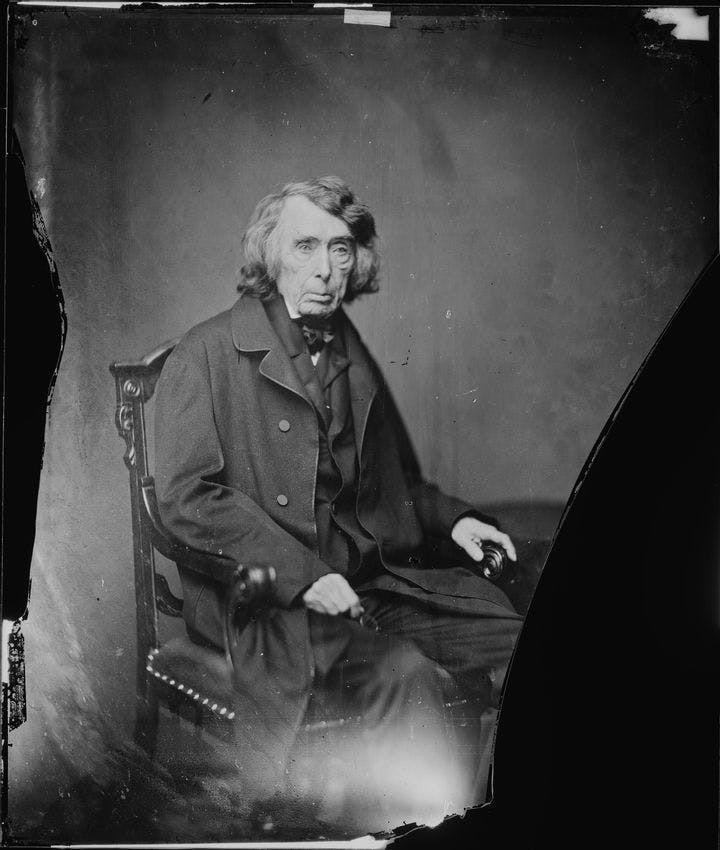Fall 2010
The Real Justice Taney
– The Wilson Quarterly
Supreme Court justice Roger B. Taney infamously described blacks as "beings of an inferior order," but he once called slavery "a blot on our national character."
Who was the real Roger B. Taney? Was he the Supreme Court justice who infamously wrote, in the 1857 Dred Scott decision denying citizenship to blacks, that they had “for more than a century before been regarded as beings of an inferior order . . . altogether unfit to associate with the white race”? Or was he the impassioned lawyer from Frederick County, Maryland, who argued in 1819 that slavery was “a blot on our national character” and insisted that “every real lover of freedom confidently hopes that it will be effectually, though it must be gradually, wiped away”?
Supreme Court justice Roger B. Taney infamously described black as “beings of an inferior order,” but he once called slavery “a blot on our national character.”
Historians have long struggled to reconcile the two Taneys, Timothy S. Huebner notes. Although Taney’s antislavery statements were made during his defense of the Reverend Jacob Gruber, an abolitionist minister on trial for preaching a sermon that his accusers claimed had disturbed the peace and promoted slave rebellion, Huebner says that the 42-year-old Taney didn’t limit himself to a simple defense of his client but “went a step further, reaffirming and validating the substance of Gruber’s sermon.”
Taney’s stance carried significant political risk in a state filled with slaveholders, but it was consistent with other actions he took during that time. As a member of the Maryland Senate between 1816 and 1821, he supported several resolutions seeking to limit slaveholding, and, by 1820, had manumitted 11 of his own slaves.
But Huebner, a historian at Rhodes College in Memphis, detects a subtle shift in Taney’s perspective during the decades following the Gruber trial. As U.S. attorney general under Andrew Jackson, for instance, he authored an 1832 opinion on the constitutionality of a South Carolina law, in which he referred to African Americans as a “degraded class” whose rights existed only on “the sufferance of the white population.”
After President Jackson appointed him chief justice in 1835, Taney wrote several opinions that, Huebner says, “reflected an emerging ‘southern rights’ argument that emphasized the need to protect the property rights of slaveholders by preserving state control over slavery.” Previously, slavery had been defended mostly as a necessary evil created by the nation’s early colonists. A polarizing political climate fed by the rise of radical abolitionism squeezed middle-of-the-roaders such as Taney, and Nat Turner’s 1831 rebellion “prompted a nearly universal response of fear and dread on the part of white southerners.” By the time of Dred Scott, Huebner writes, “Taney’s thinking had evolved into full-blown extremism.” He now believed that “only states could control slavery, ruled that Congress could not prohibit slaveholding in the territories, concluded that the Declaration of Independence had no bearing on black rights, believed that slavery elevated African Americans, and abhorred the thought of emancipation.”
After Taney died, in 1864, just six months before the end of the Civil War, a pamphlet appeared comparing him to Pontius Pilate, inaugurating a continuing debate about who the “real” Taney was. Huebner doubts that a useful conclusion can be reached: “Taney’s changing views show that he was both a product and a proponent of this shifting discourse about slavery.”
THE SOURCE: “Roger B. Taney and the Slavery Issue: Looking Beyond—and Before—Dred Scott” by Timothy S. Huebner, in The Journal of American History, June 2010.
Photo courtesy of The National Archives
